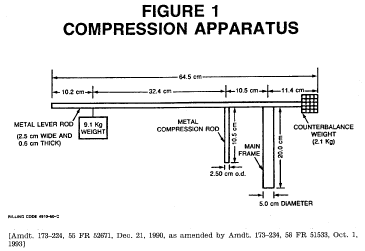Appendix D to Part 173 - Test Methods for Dynamite (Explosive, Blasting, Type A)
49:2.1.1.3.10.12.25.1.10 : Appendix D
Appendix D to Part 173 - Test Methods for Dynamite (Explosive,
Blasting, Type A) 1. Test method D-1 - Leakage Test
A wooden stick, 114 mm (4.5 inches) long and 4.8 mm (0.2 inch)
inch in diameter, with a sharpened end is used to punch 5 holes in
one end of the wrapper of a dynamite cartridge. A cork stopper is
placed on the bottom of a glass volumetric cylinder. The dynamite
cartridge is placed, perforated end down, resting on the cork
stopper in the cylinder. The entire assembly is placed in an oven
at 38 °C (100 °F) for 48 hours and then examined visually for
evidence of leakage.
2. Test method D-2
- Centrifugal Exudation Test
The test apparatus consists of a glass tube, 135 mm (5.3 inches)
long and one inch in diameter, with both ends open, and is
assembled in the following manner:
(a) Close the bottom with a plastic plug of diameter equal to
the inner diameter of the glass tube;
(b) Place a small amount of absorbent cotton on top of the
plug;
(c) Place a plastic disk that matches the inner diameter to the
glass tube and has seven small perforations on top of the cotton;
and
(d) Place 10 g (0.35 ounce) of the dynamite sample on top of the
disk.
The assembled glass tube is then placed in a hand-operated
centrifuge and spun for one minute at 600 rpm (revolutions per
minute). The dynamite sample is then removed from the glass tube
and weighed to determine the percent of weight loss. 3. Test method
D-3 -
Compression Exudation Test
The entire apparatus for this test is shown in Figure 1 of this
appendix. The test is conducted using the following procedures:
(a) A glass tube, 135 mm (5.3 inches) long and one inch in
diameter, is held on a wooden base;
(b) A small amount of absorbent cotton is placed into the bottom
of the glass tube;
(c) Ten g (0.35 ounce) of dynamite sample are placed on top of
the cotton in the glass tube;
(d) A small amount of absorbent cotton is placed on top of the
dynamite sample;
(e) A plastic disk that matches the inner diameter of the glass
tube and has seven small perforations is placed on top of the
cotton;
(f) A plastic plug matching the inner diameter of the glass tube
is then placed on top of the disk;
(g) The glass tube assembly is placed under the compression rod,
and compression is applied by means of the weight on the metal
lever rod. The sample is compressed for one minute; and
(h) The dynamite sample is then removed from the glass tube and
weighed to determine the percent of weight loss.
